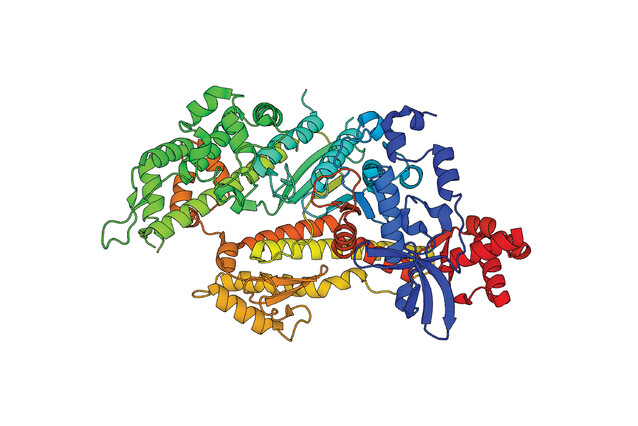Keeping muscle cells fit: how one helper protein does the trick

Chaperones are molecular machines that ensure all proteins in the cell acquire their correct shape. UNC45 is one such chaperone, an essential factor with a vital role in maintaining muscle health by ensuring myosin—a fundamental protein for muscle movement—remains in peak condition. It achieves this by directing faulty myosin toward removal pathways and healthy myosin toward assembly pathways. Researchers from Tim Clausen’s lab at the IMP have now revealed how the process is regulated, also shedding new light on how defects in myosin quality control can lead to severe muscle diseases. Their findings were published in the journal Nature Communications.
Muscle movement depends on the interaction between two key proteins: actin and myosin. These molecules slide past each other to generate power, and to function properly they are arranged in a precise, almost crystal-like structure within the sarcomere–the fundamental unit of muscle cells. Maintaining the precise arrangement of actin and myosin is crucial for muscle health, especially during exercise, under stress, and as we age.
To help proteins achieve their correct shape, a variety of molecular helpers–chaperones–are employed throughout all cell types. These act as caretakers, assisting proteins in correctly folding and assembling. For myosin, being properly structured is particularly crucial, as it comprises about 16 percent of all muscle cell proteins.One essential factor for this job is UNC45, present in all eukaryotes and identified through genetic screens as a critical player in keeping myosin in shape and maintaining the overall structure of the sarcomere. The significance of this chaperone is also underscored by severe muscle diseases—or myopathies—that are the result of mutations in the UNC45 gene.
Beyond its role in helping myosin fold correctly, UNC45 also helps tag and remove faulty proteins, ensuring that only optimal myosin remains in muscle cells. However, the precise molecular mechanism by which UNC45 fulfils its dual role in keeping muscle cells healthy has remained unknown.
Researchers from Tim Clausen’s lab at the IMP have revealed the molecular details of how UNC45 mediates both processes. The scientists discovered that the chaperone can differentiate between healthy and damaged myosin, and direct it into appropriate assembly or degradation pathways depending on its folding state. The findings also directly link myosin quality control to myosin-related muscle diseases, revealing a previously unexplored connection. The scientists now published their study in the journalNature Communications.

To degrade or not to degrade, that is the question: how a molecular helper holds the key to muscle health
Incorrectly shaped proteins–myosin included–are identified and targeted for degradation through a process called ubiquitination, where a small molecule called ubiquitin is attached to them. This tagging marks proteins for breakdown, ensuring that only fit ones are preserved. Such a quality control mechanism is also crucial for keeping muscle cells healthy and functioning properly. During this process, UNC45 interacts with a protein evaluator–that of the class of E3 ubiquitin ligases–enabling it to selectively channel faulty myosin molecules to their breakdown.
To understand how UNC45 distinguishes between healthy and faulty myosin, researchers recreated their interaction using proteins from the model organism C. elegans, a nematode worm. They employed advanced techniques, including crosslinking mass spectrometry, to identify the exact contact points between the chaperone and myosin. This method chemically links interacting proteins, allowing scientists to see where and how they connect.
“The chaperone UNC45 can interact with both properly folded and incorrectly shaped myosin, resulting in different functional complexes,” explains Antonia Vogel, former student in the Vienna BioCenter PhD Program at the Clausen lab. These connections determine whether the myosin is structurally sound. One complex will be prone to ubiquitination and degradation, while the other will not, with the myosin's folding state determining its own fate. “We found how different elements of the protein quality control system in muscle cells work together and compete to decide whether a protein gets folded correctly or is tagged for removal,” concludes Vogel.
To understand how myosin interacts with UNC45 at a structural level, researchers used X-ray crystallography, a technique that achieves detailed atomic resolution of proteins. Purified proteins are first turned into a crystal, then irradiated with high-energy beams. The resulting radiation patterns provide clues on the structure of the protein. “We discovered that one specific part of myosin, the FX3HY motif, plays a crucial role in recruiting and connecting to UNC45”, says Renato Arnese, Research Assistant in the Clausen lab. “This motif acts as a recognition signal that is consistently found across different organisms”.
Other than being essential for this chaperone-substrate interaction, it is also involved in human pathology. “Several site-specific mutations in this region prevent UNC45 from connecting with myosin, causing the protein to never reach its proper shape,” explains Arnese. Additionally, a single point mutation in the FX3HY motif is linked to a severe developmental myopathy, the Freeman Sheldon Syndrome (FSS).
“Our findings establish the first direct connection between defects in myosin quality control and the onset of myopathies,” says Tim Clausen. “The fact that mutations in myosin and UNC-45 that cause disease in humans are also replicated in C. elegans makes this model system highly valuable for studying such conditions.”
The study paves the way to better understand how other client-specific chaperones work, and to investigate whether other muscle diseases could stem from issues with myosin quality control.
Original publication
Antonia Vogel*, Renato Arnese*, Ricardo M. Gudino Carrillo, Daria Sehr, Luiza Deszcz, Andrzej Bylicki, Anton Meinhart & Tim Clausen “UNC-45 assisted myosin folding depends on a conserved FX3HY motif implicated in Freeman Sheldon Syndrome.” Nature Communications (2024). DOI:10.1038/s41467-024-50442-6
*These authors contributed equally.
Further reading
About the Vienna BioCenter PhD Program
Much of the work underlying this publication was done by doctoral students of the Vienna BioCenter PhD Program. Are you interested in a world-class career in molecular biology? Find out more: https://training.vbc.ac.at/phd-program/